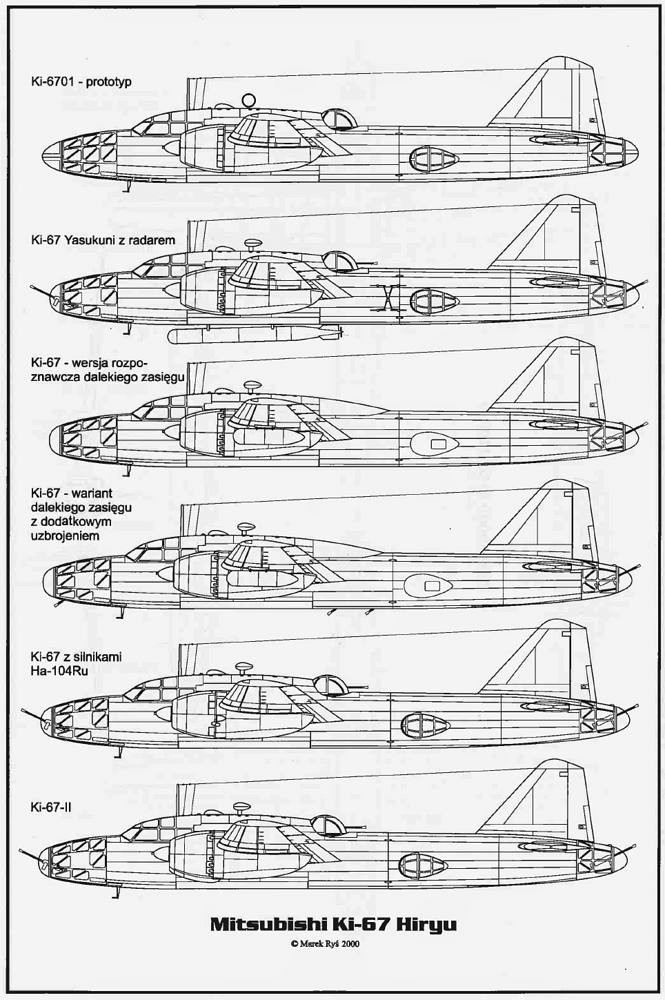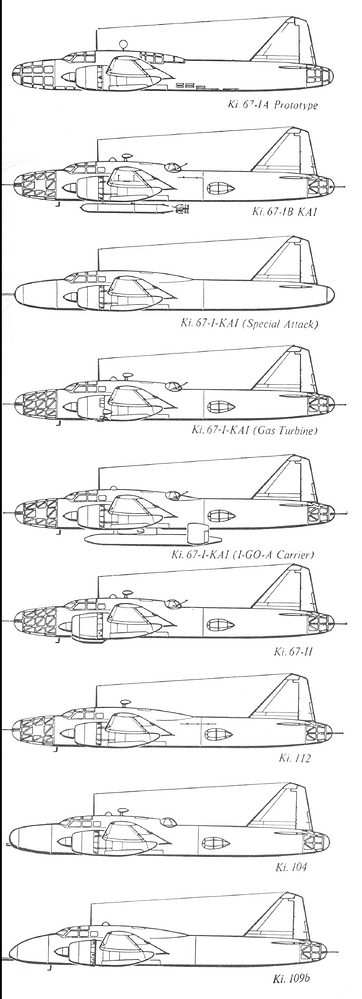- Yes
- No

Mitsubishi Ki-67-I with Ha-104 Ru engine (三菱 Ki-67-I ハ104ルエンジン搭載)
The Mitsubishi Ki-67-I with Ha-104 Ru engines is an experimental version of the Ki-67 that aimed to test performance improvements at high altitudes. In 1944, examples of this aircraft were created from the conversion of two production Ki-67s with serial numbers 2 and 3 or 21 and 22.
History
In early 1944, when work on the prototype and pre-production Ki-67 at Mitsubishi was completed, the problem of not achieving maximum aircraft performance at high altitudes remained unresolved. The design requirements stated that the aircraft should reach a speed of 550 km/h, but the prototype and pre-production Ki-67 powered by the Ha-104 engine only achieved a maximum speed of 537 km/h. It was decided that to meet the army’s requirements, turbocharged engines needed to be used. However, in order not to delay the production of the Ki-67 again, it was decided to modify two already being produced Ki-67s and conduct tests in this way. If it turned out that the increase in power and speed at high altitudes would be satisfactory, the remaining Ki-67s would be reworked. Production aircraft Ki-67 2 and 3 or 21 and 22 were selected (sources lack accuracy) and in January 1944, the modification of these aircraft began. It was decided to use Ru-3 turbochargers. Work began on January 17, 1944. The first Ki-67 with Ha-104 Ru engines (no. 2 or 21) was ready at the beginning of March, and it made its first flight on March 3, 1944. The second modified Ki-67 (no. 3 or 22) was only ready in May 1944, and it flew for the first time on May 17 of the same year. These aircraft underwent internal testing at the Mitsubishi facilities, and on June 28, the planes were sent to a military commission for further testing. These tests lasted until October 1944, when it turned out that the standard Ki-67 performed excellently and that performance improvements at altitude were unnecessary. The modified Ki-67 with the Ha-104 Ru engine reached 555 km/h at 6100m and 490 km/h at 8500m. For this reason, the project to equip all Ki-67s with Ha-104 Ru engines was abandoned, as the performance increase was minimal and the turbochargers were highly unreliable. However, it was planned to equip the heavy fighters Ki-109 with Ha-104 Ru engines, but it is unknown whether this was actually done. It is not known exactly what happened to the modified Ki-67 afterwards, but it is likely that the Ha-104 engines were reinstalled in them.
Construction description
The Mitsubishi Ki-67-I with Ha-104 Ru engines is almost identical to the standard Ki-67-I Ko. The only differences are the use of the Ha-104 Ru engine instead of the Ha-104 and the changed engine cowling.
Construction details

General characteristics
- Crew: 8
- Length: 18,7 m
- Wingspan: 22,5 m
- Height: 5,6 m
- Wing area: 65.0 m2
- Empty weight: 8649 kg
- Gross weight: 13765 kg (?)
- Powerplant: 2 x Mitsubishi Ha-104 Ru engine with a take-off power of 1,397 kW (1,900 HP), equipped with a turbocharger, each.
- Propellers: Adjustable four-blade metal propeller with a constant rotational speed of 3,600 mm in diameter.
Performance
- Maximum speed: 555 km/h
- Cruising speed: 400 km/h (?)
- Range: 2800 km (?)
- Maximum Range: 3800 km (?)
- Service ceiling: 9470 m (?)
- Climb Rate: ?
- Rate of climb: ?
Armament
- Guns:
- 1 x 12.7mm Ho-103 machine gun in the nose (500 rounds)
- 2 x 12.7 mm Ho-103 machine gun in side position behind the wings (400 rounds each)
- 1 x 12.7mm Ho-103 machine gun in the tail (700 rounds)
- 1 x 20mm Ho-5 cannon in dorsal turret (300 rounds)
- Bombs
- 1 x 800 kg bomb (in the bomb bay)
- 1 x 500 kg bomb (in the bomb bay)
- 3 x 250 kg bomb (in the bomb bay)
- 8 x 100 kg bomb (in the bomb bay)
- 15 x 50 kg bomb (in the bomb bay)
- 1 x Type 91 Aerial Torpedo (all versions) (?)
Armour
- 70mm bulletproof glass front glass
- 12.7 mm thick armor plate in front of pilots
- 15.8 mm thick armor plate pilot seats
- 15.8 mm thick armor plate behind the dorsal turret
- 7.9 mm thick armor plate under the tail gunner
- Self-sealing fuel tanks in the fuselage, covered with 16 mm rubber, and equipped with a carbon tetrachloride extinguishing system
- Self-sealing fuel tanks in the wings, without 16 mm rubber coating, equipped with a system for extinguishing and neutralizing fuel vapours.
Special thanks
Summary
The Mitsubishi Ki-67-I with Ha-104 Ru engines is an interesting aircraft for Japan in War Thunder. This aircraft would be a good high-altitude bomber with good performance, allowing it to better evade enemy fighters. I encourage you to discuss in the comments and to share your own knowledge on this subject.
Finally, I apologize for the linguistic and logical errors because unfortunately English is not my main language and I had to use google translator.
Internet sources
四式重爆撃機 - Wikipedia
Mitsubishi Ki-67 - Wikipedia
Micubiši Ki 67 Hirjú [Peggy] : Micubiši
Уголок неба ¦ Mitsubishi Ki-67 Hiryu
Mitsubishi Ki-67 Variants and Derivatives (Ki-69, 109, 167) | Secret Projects Forum
Mitsubishi Ki 67 Peggy
Japanese Aircraft of WWII: Mitsubishi Ki 67 Peggy Redux
Info: Japanese Army Aircraft of the Pacific War - Page 4 - Axis History Forum
Book sources
- Mitsubishi Ki67 - Ki109 Hiryu in Japanese Army Air Force Service - PDF Room | PDF
- Japanese Aircraft of the Pacific War page 186-191
- Technika wojskowa historia 5/2022 (Military Technology: History 5/2022) page 76-77
- Lotnictwo wojskowe 3/2000 (Military Aviation 3/2000) page 28

Thank you for reading the suggestion, see you in the next one. Good luck pilots



